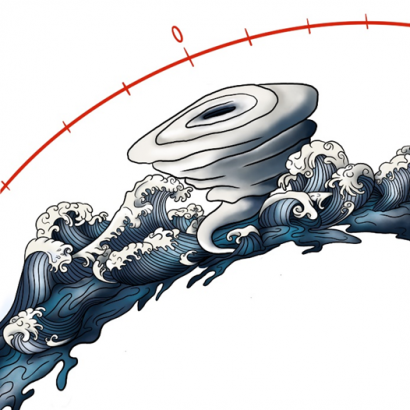TROPICAL WAVES TRIGGERED RARE NEAR-EQUATORIAL TROPICAL CYCLONE GENESIS, LEADING TO DEADLY IMPACT
A new study published in Nature Communications identified meteorological conditions resulting in a rare cyclone formation near the equator.
In March and April 2021, these conditions caused the development of Tropical Cyclone Seroja, which led to the death of at least 272 people in Indonesia and East Timor. The collaborative study was conducted by researchers from Poland, France, the USA, Indonesia, and the UK, with Beata Latos, a Ph.D. student from the Institute of Geophysics of the Polish Academy of Sciences, as the lead author.
What makes Tropical Cyclone Seroja stand out?
According to the study's lead author, Beata Latos, "The genesis of Tropical Cyclone Seroja occurred relatively close to the Equator, which is very unusual because the planetary vorticity is weak in this region, making it a cyclone-free area." Normally, tropical storms develop over open oceans between 10° and 20° poleward from the equator, and in the Maritime Continent, they mostly occur in the southeastern Indian Ocean, between Indonesia and Australia. However, Cyclone Seroja formed in the Timor and Savu Seas, close to a landmass. This proximity, combined with the serious damage caused by the cyclone, makes it unique.
"It was also apparent that some of the most significant damage in the Maritime Continent occurred before Seroja reached the sufficient threshold to be considered a Tropical Cyclone. Therefore, we looked at the pre-genesis stage and documented that the vorticity associated with Convectively Coupled Equatorial Waves provided a sufficient impulse to enhance Tropical Cyclone development, even in relative proximity to the Equator," Latos noted.
What caused the cyclogenesis?
The unusual near-equatorial cyclogenesis close to a landmass was due to "perfect storm" conditions resulting from the interaction of multiple weather systems. Various tropical weather systems arrived simultaneously, creating favorable conditions for enhanced convection and spatial organization. The "Madden-Julian Oscillation," the largest of these weather systems, moved slowly eastward from the Indian Ocean over Indonesia. The interaction between two "Kelvin waves" and a "Rossby wave" spun up the initial vortex and accelerated the cyclone's development.
This led to the formation of a low-pressure system, heavy rainfall, and intense winds. "It was a truly multi-scale event that originated from enhanced diurnal convection over New Guinea several days before cyclogenesis. The convection was intensified by interactions with several large-scale modes in atmospheric circulation, enhanced by unusually warm waters of the Banda Sea," explained Dr. Dariusz Baranowski, a co-author of the paper from the Institute of Geophysics of the Polish Academy of Sciences.
Why is this important?
"The cyclone triggered extreme weather, which resulted in flash floods and landslides at many locations in the region." – informed dr Nely Florida Riama from the Agency for Meteorology, Climatology, and Geophysics of Republic of Indonesia (BMKG). The study's new findings provide tools for better prediction of tropical cyclones, including rare near-equatorial events. “A lot of study had already documented the genesis and formation of tropical cyclones driven by one or two weather systems, like the MJO and a Kelvin wave. Tropical Cyclone Seroja teaches us that multiple waves occurrence is one other mechanism that can allow a “perfect storm” to develop, even in unfavorable conditions like those met close to the equator. The monitoring and forecast of such weather systems opens a rich forecasting and research perspective for tropical cyclone.” - mentioned Philippe Peyrillé, a co-author from the Centre National de Recherches Météorologiques Université de Toulouse, Météo-France, CNRS. The research also enables the study of tropical cyclone formation in a changing climate. While much research has been conducted on tropical cyclones in a warming climate, relatively little has been said about the role of Convectively Coupled Equatorial Waves. "We hope that our research will provide an impulse to study equatorial waves in Intergovernmental Panel on Climate Change model scenarios," said Latos.
Article and author details
“The role of tropical waves in the genesis of Tropical Cyclone Seroja in the Maritime Continent”
Corresponding author: Beata Latos
Institute of Geophysics, Polish Academy of Sciences, Poland
E-mail: blatos@igf.edu.pl
DOI
https://doi.org/10.1038/s41467-023-36498-w
Online paper
https://www.nature.com/articles/s41467-023-36074-2
Institute of Geophysics, Polish Academy of Sciences, Poland
E-mail: blatos@igf.edu.pl
DOI
https://doi.org/10.1038/s41467-023-36498-w
Online paper
https://www.nature.com/articles/s41467-023-36074-2






















